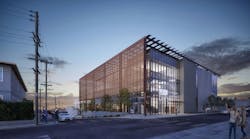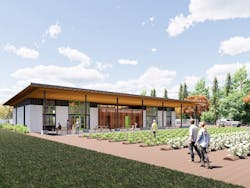Regenerative design is becoming the new darling of the sustainability movement. The objective is to create a building that is self-sustaining and produces positive impacts. It requires designers to embrace a vision of architecture that is “doing good” rather than merely “less bad.”
To better understand this strategy, we talked to three regenerative leaders about the core tenets of regenerative design: Colin Rohlfing, director of sustainable development at HDR; Paul Hutton, director of regenerative design for Cuningham Group Architecture; and Jennifer Wehling, director of sustainability with HMC Architects. Here are their insights into this emerging trend:
1) It’s more than sustainable design.
There’s firm agreement among regenerative design champions that the term sustainability no longer captures our pressing environmental reality. It’s also possible it was never the right standard to begin with. After all, sustainable buildings reduce but don’t eliminate the use of finite resources.
Rohlfing: Sustainability started as a homeostasis for no harm done. But then it became mundane, like a 10% reduction in water. Regenerative design sets an ecological benchmark that is pre-industrial, pre-agricultural and pre-development. That means net positive in all categories.
Hutton: The term sustainability is fatigued and ready to retire—it’s not up to solving the problems we’re facing today. Regenerative design is more of an attitude and approach than a checklist of results or reductions. Regenerative moves beyond net zero to create positive environment impacts. Nature does it all the time; we just need to get smarter about design.
Wehling: Remember there’s a spectrum of buildings: code compliant is the lowest threshold, high performance means resource efficient, sustainability is not taking more than needed, restorative actually repairs and regenerative is self-sustaining. Regenerative compels us to reverse damage to the planet.
2) Regenerative design gives back.
Regenerative design upgrades the old mantra of “recycle, reduce and reuse” to “restore, renew and replenish.” Imagine a building that actively contributes back to the ecosystem.
Hutton: If we only seek to achieve less harm, then that’s the best we can ever do. We won’t have motivation to go beyond reducing electricity and fossil fuels. We’ll be mindful of water but not capture or recycle it. We won’t be compelled to pay attention to embodied carbon either. We simply can’t stop here.
Wehling: Regenerative design isn’t just about saving the planet, it’s saving the humans too. We have to ask more from building design. That means implementing architectural strategies that address air pollution, clean water, repair forests and decrease the heat island effect.
3) Every design choice matters.
Regenerative design pushes architects to adopt new planning practices. Everything from site research to engineering and material selection requires a holistic approach. But that’s the opportunity to be innovative.
Wehling: Step one is realizing that every decision we make has an impact, from the building orientation to choosing a ceiling tile. Architects are problem solvers. Regenerative design challenges us to give the client the most while minimizing our footprint.
Rohlfing: Maladaptive design can’t just be tweaked—we have to break it and start over. Regenerative design isn’t based on a sketch or aesthetics. It starts with a deep analysis of place: site hydrology, community health, social equity, carbon cycles and biodiversity. Regenerative design uses a level of scientific discovery and biology that doesn’t happen on conventional projects.
Hutton: One way to move the needle is stop building on greenfield sites. We cannot keep usurping natural habits for manmade structures. There are existing buildings that can be preserved and rehabilitated. There are brownfield sites waiting to be reclaimed. Focus on densifying urban locations.
4) Design today for the future.
There’s a strong likelihood that green facilities will be a necessity down the road rather than a nice gesture. Carbon mandates, electrification and extreme weather events are already highlighting how buildings need to be part of the solution. How can a project be ready for the unknowns of 20, 50 and 100 years in the future?
Wehling: Even if a project doesn’t have the full budget today, we can plan ahead so it can evolve into net zero. That means changing our idea of what “good” architecture and landscaping looks like. It could be as simple as removing turf grass, which has no ecological benefit; it’s not the usual aesthetic but the alternatives can be attractive in a different way.
Rohlfing: We should be designing for future resiliency. Regenerative design is only one point in time; regenerative development is over a period of time. We need projects that can be a steward for evolving metrics. The future could bring any number of shifts, such as relative humidity and temperature, social equity or ethnography – buildings must be adaptable.
Jennie Morton has been covering the built environment for the past 12 years.
Read next: Regenerative Design Doesn’t Start with a Napkin Sketch
About the Author
Jennie Morton
A former BUILDINGS editor, Jennie Morton is a freelance writer specializing in commercial architecture, IoT and proptech.


